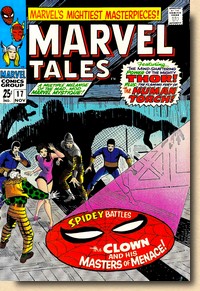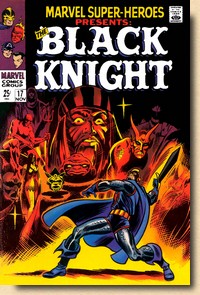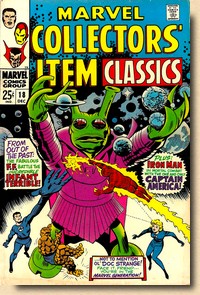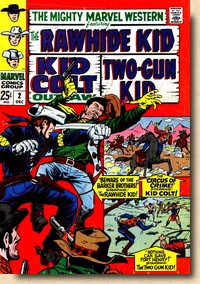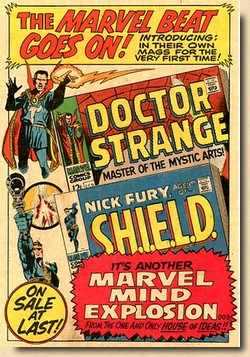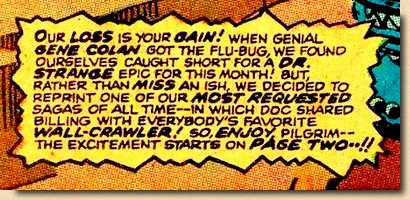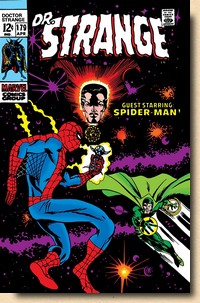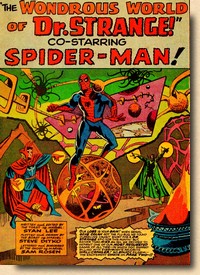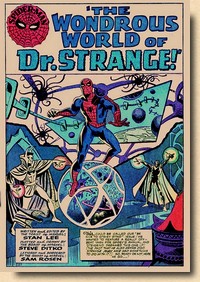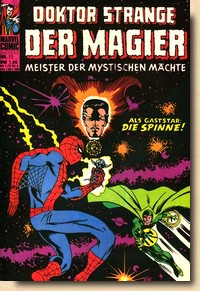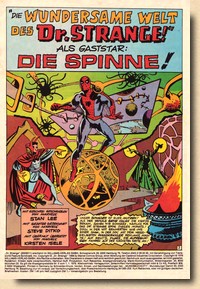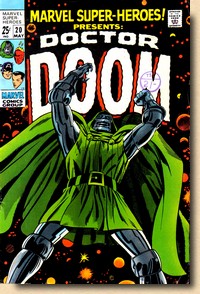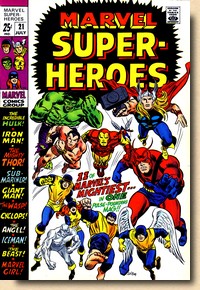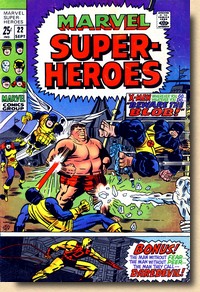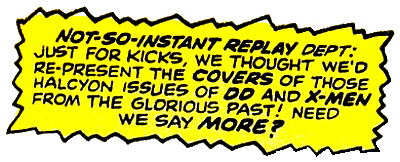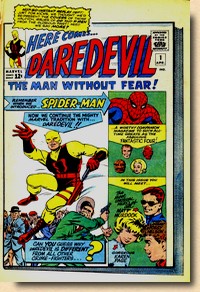 |
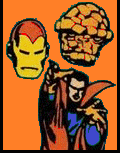 |
|
MARVEL
REPRINT TITLES
OF
THE 1960s
Part
Three (late 1967 to 1969)
|
|
|
|
| |
|
|
| |
|
| |
KEYWORDS TO SUCCESS: "MARVEL"
AND "SUPER-HEROES"
|
| |
| The steady bi-monthly
publication schedules of Marvel's three reprint titles Marvel
Tales, Marvel Collectors' Item Classics and
Fantasy Masterpieces was subject to sudden
changes when the
December 1967 cover date production slot rolled around -
and the changes came with more than just one twist. The first was a less than obvious
change of title, as Fantasy Masterpieces #11
(October 1967) was followed two months later not by Fantasy
Masterpieces #12 but rather Marvel Super-Heroes
#12 (cover dated December 1967, on sale October 10th 1967).
|
| |
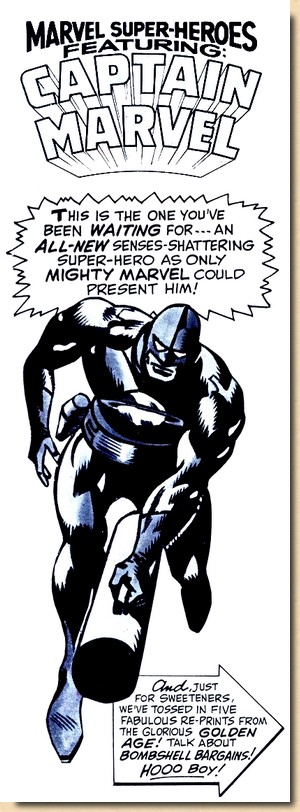
|
|
With
no actual announcement
made to the title change,
the continued numbering
was the only clue to what
was happening, even
though Marvel
Super-Heroes #12
featured most prominently
in Stan Lee's op-ed Stan's
Soapbox on the
Bullpen Bulletin page:
"Every
so often we like to toss
a completely unexpected
bombshell surprise at
you. Well, we've got one
for you now! We decided
to mention it in this
space, which is the most
widely-read paragraph in
all of comicdom, so that
none of you will miss it.
Just for kicks, yours
truly and Genial Gene
Colan have created a
brand new superhero who
we think is destined to
become an overnight
sensation.
|
|
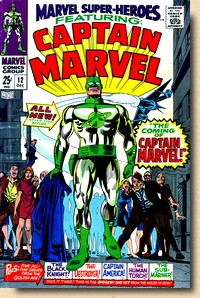
Marvel
Super-Heroes #12
(December 1967)
|
His
name - CAPTAIN MARVEL !! We
don't wanna say anything more
about him now, except to tell
you that he's starring right
now in MARVEL SUPER-HEROES.
It's on sale right now!"
(January
1968 Bullpen Bulletin)
There are,
however, a few aspects of this
communication which don't hold up
to closer scrutiny - and that is
twist number two: Captain Marvel
was neither a "brand new
superhero" nor did Stan
Lee and Gene Colan come up with
the character "just for
kicks".
By mid-1967
Martin Goodman and Stan Lee had
cornered the comic book market
and taken the top spot. Nobody
was outselling them, and their
dominance and business success
was pretty much down to two
keywords only: Superheroes
and Marvel.
Their take on
the first was innovative and
highly popular, and their brand
enjoyed wide recognition and a
fan following even outside of the
comic book market segment.
But there was
a problem.
Way back in
1939, writer Bill Parker and
artist Charles Clarence Beck had
created a superhero they chose to
call Captain Marvel. Originally
published by Fawcett Comics, he
made his debut in February 1940
in Whiz Comics #2.
|
|
|
|
| |
| In this
first incarnation, Captain Marvel was actually adolescent
radio news reporter Billy Batson who is given super
powers by an ancient wizard; he only needed to say the
magic word "Shazam!" and - struck by
magic lightning - instantly turned into Captain Marvel, "the world's mightiest
mortal". The character, now in his own title,
quickly became a top seller - so much so that Fawcett
received a cease-and-desist letter from National Comics
Publications (DC Comics) in June 1941, who felt that
Captain Marvel was a Superman knockoff. |
| |
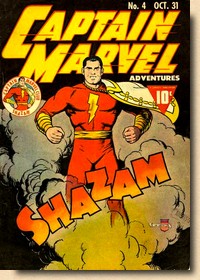 Captain
Marvel Adventures #4 Captain
Marvel Adventures #4
(Fawcett, October 1941)
|
|
Turning into
one of the longest running legal
battles in comic book publication
history, Fawcett finally sought
an out of court agreement and in
1954 paid National $400,000 in
damages and agreed to cease
publication of all Captain Marvel
related comics. By that time, the
sales of superhero comics had
decreased dramatically, and
Fawcett shut down its entire
comic book branch.
For quite
some time, that was the end of
Captain Marvel - until publisher
Myron Fass took up the all but
forgotten and dormant (and hence
copyright-free) name and came up
with his version of Captain
Marvel (which is almost too wacky
to explain - in essence, this
incarnation could split and
rejoin parts of his body by
uttering "split"
and "xam"
respectively). Published in four
issues between April 1966 and
September 1967, the title put the
name Captain Marvel back in use -
and gave Fass the publishing
rights to it.
Goodman
clearly saw Fass's move for what
it was: the attempt to cash in on
Marvel and other publisher's
successes was thinly veiled, if
at all.
|
|
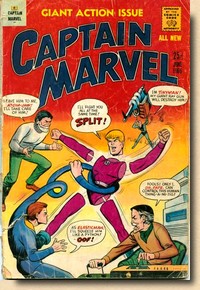
Captain
Marvel #2
(MF Enterprises, June 1966)
|
|
|
|
| |
| Fass's
Captain Marvel did indeed
contain a whole slew of embarrassingly
close copies of well-known characters,
including from DC, and it set off
Goodman's alarm bells. Given the lawsuit
of the 1950s, any possibility of DC
getting involved and possibly retaking
rights to the name Captain Marvel had to
be prevented, and Marvel's only way to
make sure of that was to act themselves. Which is why Marvel
Super-Heroes #12 featured yet
another Captain Marvel. Goodman had
beaten everybody else to it by being the
first to infringe on Myron Fass's newly
established usage of the character name,
quickly pasting him into a reprint book
and changing its title to include Super-Heroes,
just to be sure. In 1968, Fass agreed to
a one-time payment of $4,500; in return,
he dropped a legal suit he was preparing
and Marvel got to trademark the name
(Howe, 2012). The two keywords to
Marvel's success were safe - so much so
that when
DC licensed the rights to all of
Fawcett's superheroes in 1972 and revived
the original Captain Marvel in his own
title, they had to call it Shazam
(and drop the tagline "THE
ORIGINAL CAPTAIN MARVEL" after
a few issues, following a call from
Marvel's lawyers).
There was a final
twist, albeit only from the perspective
interested in Marvel's reprint titles.
With the change of title came a change in
concept, which reflected the modus
operandi of the annuals: add a few
pages of new material with lots of
reprint material, and you instantly
enlarge the potential customer base.
|
|
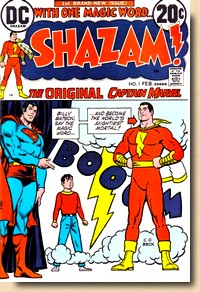
Shazam #1
(DC, February 1973)
|
|
|
| |
| In this case, the all-new
copyright-winning 15 page story "The Coming of
Captain Marvel!" (by Stan Lee and Gene Colan) was
accompanied by the original Human Torch in "The
Threat of the Jet" (first printed in Men's
Adventures #27, May 1954), the Destroyer in
"The Beachhead Blitz!" (All-Winners Comics #12,
Spring 1944), Captain America in "Kill Captain
America!" (Men's Adventures #28, July
1954), Black Knight in "The Abduction of King
Arthur!" (Black Knight #1, May 1955) and
the original Sub-Mariner in "The Sub-Mariner
Strikes!" (Sub-Mariner #38, February 1955). When the fans cast their votes for
the 1967 Alley Awards, Martin Goodman's good business
sense and Stan Lee's deft publishing delivery proved a
double winner as Fantasy Masterpieces grabbed
the award for the year's "best all reprint
title" and Marvel Super-Heroes did the same
for the "best combination new and reprint material
title".
|
| |
| |
"MARVEL'S
MIGHTIEST MASTERPIECES"
|
| |
| As the first 1968 cover
date production cycle rolled around, Marvel's line of
reprint titles steadily kept presenting readers with "Marvel's
mightiest masterpieces" and, when it came to
mixing in Golden Age material from long ago, rushing in "mixed-up
memory time". Marvel Tales #12
was the January 1968 reprint title while the reprint
title for February 1968 was Marvel Collectors' Item
Classics #13. Both titles had now
switched from the previous "four covers on one
cover" formula to simply featuring single theme
covers - no doubt a better selling point at the
newsstands.
|
| |
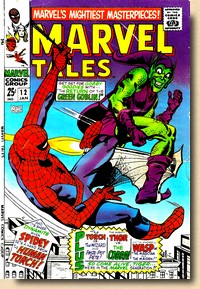
Marvel
Tales #12
(January 1968)
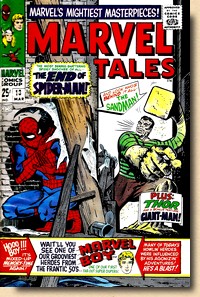
Marvel
Tales #13
(March 1968)
|
|
In the case
of Marvel Tales #12 this
was a composite
of the Spider-Man figure from the
cover of Amazing Spider-Man
#17 (reprinted in this issue) and
the Green Goblin figure from the
cover of Amazing Spider-Man
#39 (not actually reprinted in
this issue).
Other than
Spider-Man readers got to read
reprints featuring the new Human
Torch, the Wasp, and Thor.
Marvel
Collectors' Item Classics #13 simply
featured the cover of Fantastic
Four #18 (reprinted in this
issue) and featured additional
reprints featuring Iron Man,
Doctor Strange, the Watcher, and
the Hulk.
Marvel
Tales #13 (March 1968)
featured Golden Age material for
the first time by introducing
Marvel Boy from 1950, while Marvel
Super-Heroes #13 continued
with the all-new Captain Marvel
material alongside more Golden
Age material that same month; the
April 1968 cover date publishing
cycle only featured one reprint
title, Marvel Collectors'
Item Classics #14.
But while
Marvel's two by now
long-established, king-size
reprint titles kept to their
alternating bi-monthly
publication schedule like
clockwork, Marvel's approach to
labelling reprints was changing
once again.
Whereas both Marvel
Tales #12 (January 1968) and
Marvel Collectors' Item
Classics #13 (February
1968) featured the by now common
(and often rather large)
arrow-shaped box with the
"originally presented in
..." message on the splash
page of each feature, this
information was scaled down
considerably for the following
issues of both titles. In fact,
one might argue that it was all
but hidden from readers, as the
only way of telling (for someone
who did not know otherwise
already) that this comic
contained reprints, was reduced
to a small line blended into the
original artwork.
|
|
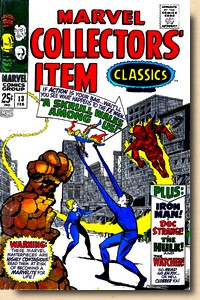
Marvel
Collectors' Item
Classics #13
(February 1968)
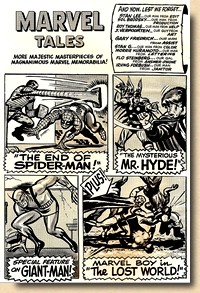
Marvel
Tales #13
(March 1968)
|
|
|
|
| |
There was also no
reprint information contained on the
inside cover page, and readers thus lost the
information they had previously had as to
which title and issues originally
featured the repinted story.
As
of Marvel Tales
#14 (May 1968) and Marvel Collectors'
Item Classics #15 (June 1968) the reprint
information was moved to the bottom of
the indicia on the first page of every
issue.
Martin
Goodman felt
the need to switch gears and be somewhat
less frank about Marvel's reprints - and
once again, it was his business sense
that told him to do so.
|
|
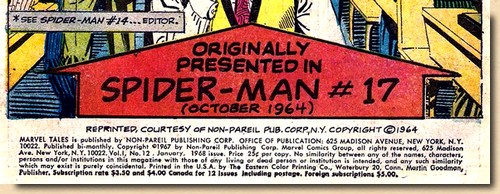
Marvel Tales #12
(January 1968)
|
|
|
| |

Above:
Marvel Tales #13 (March 1968) - Below: Marvel
Collectors' Item Classics #15 (June 1968)

|
| |
| After all, his business
sense had proven its strength time and time again. There
had, however, been a time, back in 1957, when Goodman had experienced
a rare lapse of his good business sense: he switched his
distributing company for his comics only to see his new
distributor go out of business just a few months later.
As a result, Goodman found himself with no other choice
than to switch to Independent News, which was, however,
owned by National Periodical - who also happened to own
rival DC Comics. The well-known outcome of this was
that Atlas and then Marvel Comics was limited by contract
to a monthly publishing output of eight titles only
(Cooke, 1998). As a
result, Stan Lee juggled with a mix of bi-monthlies,
cancelling Romance and Western titles, turning Horror
books into Superhero titles in order to get the
distribution slots freed up for what was selling
(Marvel's approach to the genre featuring
"superheroes in the real world"), and creating two-feature titles.
These were comic books which were essentially shared by
two different starring characters, each in their own
stories, such as Doctor
Strange and Nick Fury in Strange
Tales, the Hulk and the Sub-Mariner in Tales to
Astonish, and Iron Man and Captain America in Tales
of Suspense.
But that was now all about
to change.
|
| |
| |
"THE BEGINNING OF
THE SECOND GOLDEN AGE OF MARVEL"
|
| |
In what was the April 1968
cover date Bullpen Bulletin (but which featured in comic
books actually on sale during the first half of January
1968) Stan Lee kicked his usual hyperbole into the
stratosphere as he made the thinly veiled announcement
that all the two-feature titles were going to expand into
separate titles.
"It's finally
happened! The star-spangled Captain America and the
great green-skinned Hulk have both been awarded their
own full-length mags each month! (...) We've got some
big changes coming month after month (...) Yessir!
1968 is the year of Marvel (...) And like we said,
this is only the beginning! (...) This is the
beginning of the SECOND Golden Age of Marvel - and
it's gonna be a never-ending joyride!" (April 1968
Bullpen Bulletin)
Marvel Comics was
finally able to break free from its distribution
constraints when DC
Comics and Independent News were purchased by Kinney
National Company at the beginning of 1968. Martin Goodman had already managed to
wrangle a slightly better deal in 1967 from Jack
Liebowitz (after all, Marvel's comics were selling better
than DC's), but now any kind of distribution cap was
lifted.
|
| |
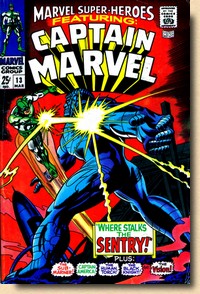
Marvel
Super-Heroes #13
(March 1968)
|
|
The result
was an explosion of new titles as
established characters finally
could be given their own comic
book (Tales of
Suspense, Tales to Astonish and
Strange Tales alone split to
become six titles instead of
three) - the title count went up
from 14 (January 1968 cover
month) to 20 (July 1968). This
expansion of titles also affected
one of the three reprint titles
as Captain Marvel branched out of
Marvel
Super-Heroes into his own
title for the May 1968 cover date
production - replaced by none
other than Spider-Man himself in Marvel
Super-Heroes #14 (May 1968),
thus continuing the formula of
adding some new material to the
mostly reprint features.
Outwardly,
the title reverted to the logo
used on the one-shot Marvel
Super-Heroes #1 from October
1966, and the Spider-Man story,
albeit written by Stan Lee, came
from inventory; originally
planned as a fill-in issue of Amazing
Spider-Man when regular
artist John Romita suffered from
a wrist injury, it was not used
to Romita's speedy recovery.
|
|
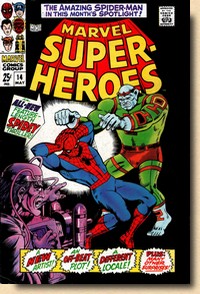
Marvel
Super-Heroes #14
(May 1968)
|
|
|
|
| |
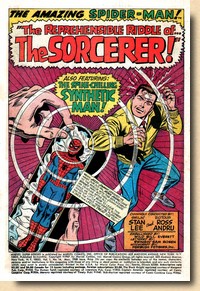
Marvel
Super-Heroes #14
(May 1968)
|
|
The
provenance of "The
Reprehensible Riddle of... the
Sorcerer!" was even
explained to readers on the
splash page, and while this was
Ross Andru's first ever pencils
on Spider-Man, he would become
the regular artist on Amazing
Spider-Man several years
later. Somewhat in
sharp contrast to the verbosity
reagarding the circumstances
surrounding the creation of the
Spider-Man feature, the Golden
Age reprints which filled the
remainder of the 68 pages were in
no way marked as such, nor could
readers determine the titles in
which the stories had first been
published - the matter-of-fact
statements "Character A
reprinted courtesy of publishing
company B" in the indicia
were all there was.
Marvel
Super-Heroes #14 was joined
by Marvel Tales #14 as
the second reprint title on
newsagent stands in February
1968, albeit cover dated May
1968.
|
|
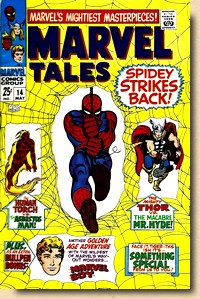
Marvel
Tales #14
(May 1968)
|
|
|
|
| |
| The June 1968 cover
production output from Marvel featured 18 titles. Of
these, only one was a reprint title (Marvel
Collectors' Item Classics #15), although also squarely set in the
superhero genre - which was driving Marvel's success
while Western, War and Romance titles were down to one
each now. |
| |
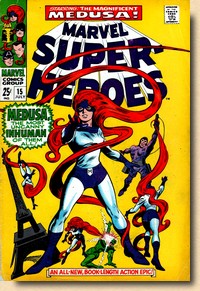
Marvel
Super-Heroes #15
(July 1968)
|
|
Marvel
Super-Heroes #15 (July 1968
cover date, on sale 9 April 1968)
featured yet another character as
the star of the original
material: Medusa of the Inhumans
(who incidentally featured as the
semi-villain of Amazing
Spider-Man #62 that very
same month). Drawn by Gene
Colan in Marvel Super-Heroes and
John Romita in Amazing
Spider-Man, Medusa's one-off
feature in Marvel
Super-Heroes #15 was one of
Marvel's first attempts to
showcase a character who is not a
clear-cut good guy (or, in this
case, good girl) in their own
feature - ultimately preparing
the groundwork for Astonishing
Tales #1 (August 1970) which
featured an outright villain as
its star: Doctor Doom.
Marvel Tales
#15 completed the reprint title
bundle for July 1968, with
reprints featuring Spider-Man,
Human Torch, Thor and the Golden
Age Marvel Boy.
|
|
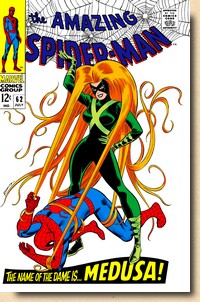
Amazing
Spider-Man #62
(July 1968)
|
|
|
|
| |
| |
THE MARVEL UNIVERSE:
EXPANDING
MARVEL REPRINTS: GOING DARK
|
| |
As Marvel's
line-up of titles kept expanding - adding
up to an unprecedented total of 21 for
the August 1968 cover month production -
Stan Lee had his own way of touching on
the subject.
"We
sometimes receive letters accusing us
of publishing too many different
titles. A number of fans have said
it's too expensive trying to buy all
our mags, and they ask us not to be
so greedy, and to publish less of
'em. So we thought you might like to
hear OUR side of it. The only reason
we constantly add new titles is
because YOU ask for them (...) you
swamp us with letters demanding more
than ever. Personally, we'd be happy
to let up a bit. Many of us,
including yours truly, haven't had a
vacation in years! But, our policy
was, is, and always will be to give
Marveldom what it asks for, and
judging by our ever-skyrocketing
sales, we're not far from the mark.
That's the lowdown, loyal one (...)
anyway, remember this: no matter how
many stories we create each month,
our credo will always be the same -
Nil Nisi Optimus - nothing but the
best! Excelsior!" (August
1968 Bullpen Bulletin)
Apart from the fact
that Stan Lee's love for Latin didn't
always ensure he got it quite right (it
should be optimum, not optimus),
Martin Goodman's new distribution deal
and the "ever-skyrocketing
sales" had, of
course, more to do with the growing
number of titles than anything else. Lee
did however have a point - "Marveldom"
was buying the new titles, so the demand
was clearly there.
The expanding line-up
also had its effect on Marvel's reprint
titles.
|
|
|
| |
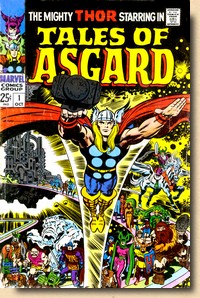
Tales
of Asgard #1
(October 1968)
|
|
Tales of
Asgard #1 (October 1968)
followed the standard reprint
"king-size" format of
68 pages selling for 25¢ and
contained reprints of the back-up
Tales of Asgard feature
from Journey Into Mystery
#97-106 (October 1963-July 1964).
A Jack Kirby
favourite, these five-page
installments each gave insights
into aspects of Norse mythology
and the biography of some of the
main Asgardian characters which
featured prominently in the
regular Thor stories. But
somehow, the God of Thunder
didn't fare too well in the realm
of reprints - Thor
Annual #2 (September 1966)
would not be followed by a third
issue until January 1971, and Tales of
Asgard #1 would remain a
single issue one-off attempt.
In terms of
labelling reprint material, Tales
of Asgard #1 continued to be
vague; in this case, the only
hint to the fact was the somewhat
implicit blurb "From the
Vintage Years of Magnificent
Marvel" on the inside
cover. Neither the indicia nor
the stories themselves carried
any other indication as to their
original source of publication.
|
|
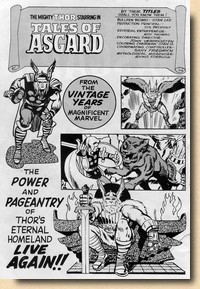
Tales
of Asgard #1
(October 1968)
|
|
|
|
| |
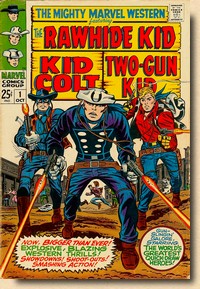
Mighty
Marvel Western #1
(October 1968)
|
|
If Tales
of Asgard #1 was a further
step down the road to going
"dark" about Marvel's
reprints, Mighty
Marvel Western #1 was the
moment that journey hit stealth
mode.
Both titles
went on sale July 16th 1968 with a
cover date of October 1968, but Mighty
Marvel Western #1 - Marvel's
first all-Western reprint title -
contained not even the slightest
hint that the material contained
on its 64 interior pages had all
been published before (namely in Rawhide
Kid #23 (August 1961), Two-Gun
Kid #61 (January 1963), Kid
Colt Outlaw #100 (September
1961), Two-Gun Kid #62
(March 1963) and Rawhide Kid
#36 (October 1963)).

Mighty
Marvel Western #1 splashpage
indicia
But not just
that - one could argue that the
cover of Mighty
Marvel Western #1 even tried
to suggest otherwise, with its
blurbs telling readers "Now:
Bigger than Ever!" and "Gun-Slingin'
Galore Starring the World's
Greatest Quick-Draw Heroes!".
It seemed as suggestive of new
material as could be without
actually using the adjective "new".
|
|
|
|
| |
Within the
span of just a few months, Marvel's policy of indicating
reprints to readers had gone from full and prominently
placed disclosure on splash pages (including title and
issue number of the original publication source) to
limiting any such indication to the very basic notices in
indicias to no indication at all.
|
| |
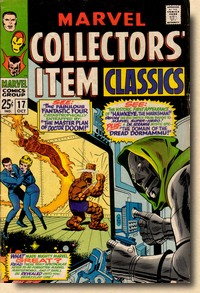
Marvel
Collectors' Item
Classics #17
(October 1968)
|
|
This
increasingly reductionist
publisher's practice was now also
accompanied by an increasingly
nebulous editorial way of
labelling reprints. Marvel
Collectors' Item
Classics #17 (October
1968) was something of a
give-away due to its title, yet
still seemed to tiptoe around
anything which might indicate
reprints, instead filling cover
bullets with labels such as "Historic
First Appearance" and "Never-To-Be-Forgotten
Marvel-Masterworks".
|
|
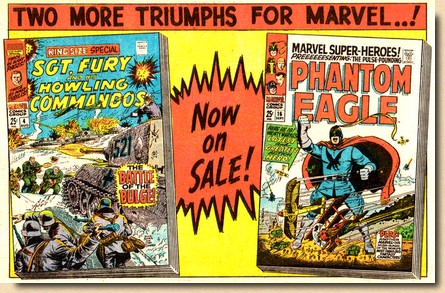
In-House
Advertising, published in Marvel
Collectors' Item Classics #17
(October 1968)
|
|
|
|
| |
| And in that very issue, an
in-house ad trumpeting "Two More Triumphs for
Marvel!" included Marvel Super-Heroes
#16 (September 1968), the cover of which contained the
blurb "Plus: Another Marvel-ous Mish-Mash of the
World's Most Fabulous Fantasy Characters!" to
label Golden Age reprints. |
| |
| |
NEW
OWNERSHIP, OLD REPRINT ATTITUDES
|
|
| |
| On July 1st 1968, the Wall Street Journal
announced the purchase of Martin Goodman's Magazine
Management Company (including Marvel Comics) by a
business conglomerate called Perfect Film & Chemical
Corporation, owned by Martin S. Ackerman. The price of
the transaction was just short of $15 million -
approximately the amount which Goodman made in sales a
year (Howe, 2012). Much
could be said about this transaction, but if put in a
nutshell it could be summarized as a shrewd businessman
(Goodman) selling his company to a "flamboyant
businessman who specialized in financially troubled
companies (...) a lawyer whose career was in mergers,
acquisitions, financial workouts and banking. Business
Week Magazine described him as a razzle-dazzle financial
operator" (Ackerman, as described by the New
York Times in his obituary of 4 August 1993).
|
| |
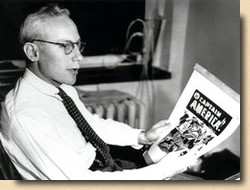
Martin
Goodman
|
|
Martin
Goodman, who had turned 60 in
early 1968, never had any
significant interest in what he
published (Hilgart, 2014); the
only thing that really mattered
to him (and in which he took some
pride) was that it sold - and he
was an ace at reading trends and
then following them.
"Martin
was one of the great
imitators of all time (...)
Whatever other people were
selling, we would do the same
thing (...) Martin was good
at what he did and made a lot
of money, but he wasn't
ambitious." (Stan Lee
in Minton, 2009)
Although
both Martin Goodman and Stan Lee
were given contracts tying them
to the new management (Goodman as
publisher for five years, Lee as
Marvel's public figurehead), work
atmosphere at Marvel changed
(Howe, 2012).
|
|
|
|
| |
| Ackerman, who was 36 when
the deal with Goodman was sealed, became president of
Curtis Publishing earlier in 1968 by lending $5 million
through the Perfect Film and Chemical Corporation, a
conglomerate that he had built. |
| |
| During his
short reign at Curtis, Ackerman
sold its Ladies Home Journal
and American Home
magazines along with its
profitable subscription and
distribution division - and
closed The Saturday Evening
Post amid protests against
his dealings. His actions drew
lawsuits from trustees and
stockholders, and he was accused
him of diverting $6 million in
pension funds. When
Ackerman's murky dealings saw him
ousted from Perfect Film board
and replaced by new CEO Sheldon
Feinberg in mid-1969, the company
was renamed Cadence Industries;
the board felt it was necessary
to distance the company from
Ackerman’s controversial
reign (Howe, 2012).
Martin
Goodman may have been steamrolled
somewhat by a "razzle-dazzle
financial operator",
but then he himself was not
exactly a philantropist in his
business dealings - a trait
clearly displayed in his handling
of reprint material.
|
|
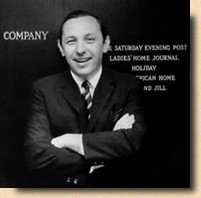
Martin
Ackerman
|
|
|
|
| |
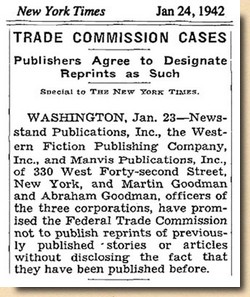
New York Times, 24
January 1942
|
|
As mentioned before, Goodman's business practices had
gotten him into some trouble with the Federal
Trade Commission before - which in 1942 even
earned him a not so honorary mention in the New
York Times.
"[Goodman]
had no respect for others’ intellectual
property, insofar as he was a blatant
imitator and published works to which he had
no rights. He created a maze of separate
companies to divide up his legal and
financial risk. He also understood
intellectual property only in the narrowest
of business senses: He paid writers and
artists once for their work, and then the
content was his to print or reprint." (Hilgart,
2014)
The
fact that Marvel reduced its labelling of
reprints to the necessary bare bones (and
sometimes even less) as of mid-1968 could
therefore also be seen as a conscious decision in
view of the impending sale.
Maybe
it was just Goodman picking up bad habits again,
or maybe it was deliberate window dressing of his
company in an attempt to boost the output
perception a bit.
|
|





























